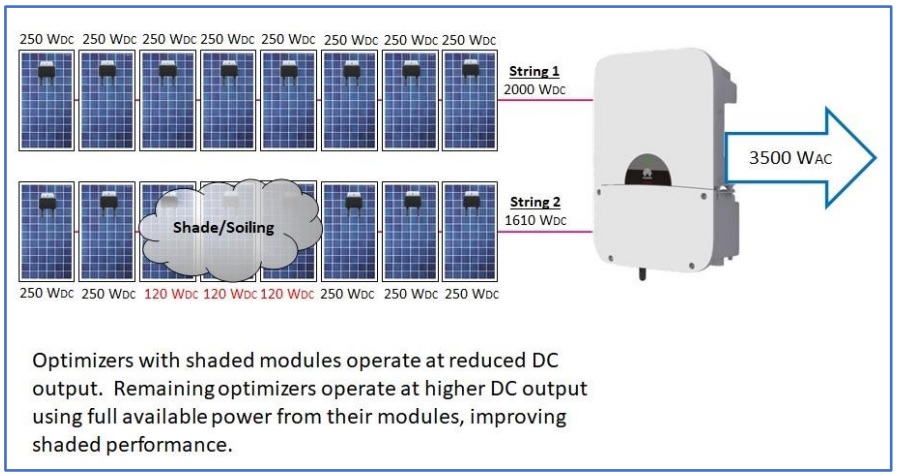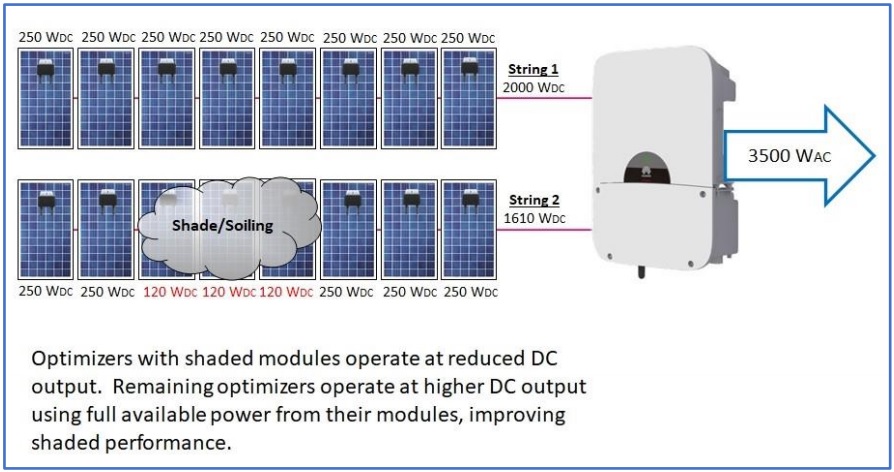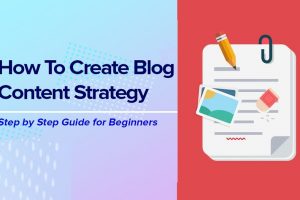There are different inverter technologies available. Each of these inverter technologies has a special case where they are used (grid or off grid). Some of these technologies have more than one use cases, especially the bi-modal and optimized string inverters. In this article, you will learn about the various ways to generate solar power for your home and the various inverter technologies available.

Various Solar Power Options for Homes
There are 3 main ways to generate solar power for your home:
- Grid Connected (with Batteries)
- Grid Connected (without Batteries)
- Off Grid
Grid Connected (with Batteries) Solar System
This type of solar system is the most expensive, with the most complicated installation steps, but it ensures that your home rarely experiences power outage. That is why this type of solar system is usually used in hospitals. For this type of solar power generation, your home uses both electric energy from utility (grid) and solar energy, with solar PV batteries as backup. The batteries store electric energy from both your solar system and the grid.
When there is power outage from both the grid and the solar system (especially at night), the electric energy stored in the batteries will be used to power your home. If your solar system generates more energy than you can consume in your home, the excess will go into the grid. If your solar system does not generate enough energy needed by your appliances, the extra energy needed will be drawn from the grid. At the end of the month, your energy consumption and generation statistics will be compared. If your energy consumption surpasses your energy generation, you will only pay for the excess consumed energy.
Grid Connected (without Batteries) Solar System
The only difference between this type of solar system and that of the grid connected with batteries is that for this solar system type, you don’t have any batteries as backup energy storage. If your solar system generates more energy than you need in your home, the excess goes into the grid. When your home require more energy than your solar system generates, this extra needed electric energy will be drawn from the grid. But if there is power failure from both your solar system and the utility (grid), there won’t be electricity in your home during this period of power outage.
Just like the other type of grid connected solar system (with batteries), you only pay for excess electric energy you used from the grid.
Off Grid (Standalone) Solar System
For this type of solar system, you home is not connected to the utility (grid). Your home depends solely on the electric energy generated by your solar system. Also, no energy is injected from your solar system to the grid.
But there may or may not be solar batteries as backup storage. If there, are batteries installed as backup, the excess energy generated by your solar system will be stored in these batteries for later use (usually at night or when there is no enough sunlight). But if there are no batteries installed as backup storage, there will always be total power outage in your home at night and partial power outage when there are not enough sunlight to generate enough energy needed by your home.
This type of solar system is usually used in rural areas where there are no access to the grid.
What is the Work of an Inverter in the Solar PV System?
The inverter is the brain house of the solar PV system that converts DC generated by the solar panels to AC, and then distributes it to the AC loads connected to it. Some inverters also have inbuilt charger section, that monitors and charges the battery bank if the system is connected to the grid and there is power available from the grid (utility mains).
Types of PV Inverters
Generally, solar PV inverters have 2 DC terminals that are connected to the batteries or to charge controllers (in absence of batteries).
There are 3 basic types of inverters:
- Square wave
- Modified (quasi) square wave
- Sine wave
Each of these inverters has a specific purpose where it can be used. Pure sine wave inverters are usually used in domestic homes.
Various Solar PV Inverter Technologies
There are 5 inverter technologies that can be used in the above mentioned solar system types:
- String Inverter
- Optimized String Inverter
- Central Inverter
- Micro Inverter
- Bi-Modal Inverter
Check:
- 5 Best Ways to Make Money from Solar Energy Sector
- How to Choose the Best Solar Batteries & Panels for your System
String Inverter Technology
String inverters usually have up to 3 separate MMPT channels where series strings of PV modules of identical type are connected. Each string has an input voltage limit, which must not be exceeded. But the string length (number of modules) on each MPPT channel must not be equal because the inverter separately optimizes the solar DC power on each MPPT channel.
Generally we know that when a module that is part of a solar array is shaded, the total power output of the array is reduced. In the case of string inverter technology, when some modules on any of the MPPT channels are shaded, only the power output of that channel is reduced, while the rest of the MPPT channels retain their maximum power output levels. This helps to reduce the effect of the shading on the entire system. But the effect of shading in string inverter technology is more pronounced than in other inverter technologies like optimized string and micro-inverter technologies.
String inverters perform best under the following conditions:
- When all the modules on the same MPPT channels are in identical orientation (that is, tilt or azimuth).
- Probability of shading occurring only in some modules of a particular MPPT channel is very low.
- If rapid shutdown of modules is not required in the system.
- When the performance of the individual modules will not be monitored.

Optimized String Inverter Technology
In optimized string inverter technology, module-level electronics is used to decentralize the MPPT function to individual modules or pairs of modules. So the optimized inverter only performs DC to AC conversion. An optimizer is incorporated in each solar module or module pair, and mounted beneath them. Each optimizer interacts directly with the solar module, extracting the possible maximum DC power. So this means that the MPPT function is actually performed by the optimizers.
When some of the modules are shaded, the unshaded modules maintain their maximum power output level. To maintain a constant DC string voltage for better DC to AC conversion, the optimizers interact with the inverter. This interaction also help to provide performance data for proper monitoring of individual module. Module-level rapid shutdown is also done by the optimizers.
Optimized string inverters perform best under the following conditions:
- If you will be using more than one PV array orientation (for example, connecting them in various sections of the roof with different orientation).
- If your solar system is designed to tolerate shading to a certain level.
- When using more than one module technology.
- If the system requires module-level rapid shut down.
- If you desire to monitor the modules individually.
- When there is an advantage or need of using different string lengths.

Central Inverter Technology
The central inverter technology is very similar to the string inverter technology. But central inverters are much larger than string inverters and also support more strings of solar panels or modules. Also, in central inverter technology, the strings of solar panels do not run directly to the central inverter like in the case of string inverters. Rather, the various solar panel strings are first connected together in a common combiner box, from where the DC power is now run to the central inverter, where it is converted to AC power.
Central inverter technology is best suited for large installations, where there is consistent energy production across the solar array. Although central inverter technology requires fewer components for connection, but 2 extra components are required – a pad and a combiner box.
Micro Inverter Technology
In micro inverter technology, both MPPT and DC to AC conversion functions are done at module level using module-level electronics. A micro-inverter is incorporated in individual PV modules or module pairs and mounted below them. An AC trunk circuit is used to interconnect the AC outputs of each micro-inverter. So the output power from the solar array is AC.
When some of the modules in a particular AC trunk are shaded, the unshaded modules (micro-inverters) in the same AC trunk still operate at the possible maximum power. Also the individual micro-inverters interact to produce performance data for monitoring. They also take care of module-level rapid shutdown.
Micro-inverters perform best under the following conditions:
- If you are planning to place your modules or sub-arrays in more than one orientation (that is tilt or azimuth).
- When you are planning to use more than one module technology in your system.
- If your solar system is designed to tolerate shading to a certain level.
- If you want to monitor the modules individually.
- When it is undesirable to bring DC power into your building.
- If the system requires module-level rapid shut down.
Bi-Modal Inverter Technology
Bi-modal inverters (also known as battery-based inverters) are usually used in homes as they can operate both in grid-connected and off-grid (standalone) solar PV systems. Deep cycle batteries is usually used as backup, so that in case of power outage from either the solar array (usually at night) or utility (grid), the power stored in the batteries will be used.
When there is power outage from the grid, the bi-modal inverter automatically switches the connected loads from the utility supply to a standalone mode (usually supported by the deep-cycle batteries). A special sub-panel in the inverter takes care of the load transfer and switching functions. There is also a battery-charging circuit that converts the AC power from the grid (utility) to DC, which is then used to charge the battery banks.
In the case of grid-connected solar system, excess power generated by the solar arrays flows to the grid.
Bi-modal inverters usually need a separate hardware – a charge controller (either PWM or MPPT type) to ensure that the charging current from the solar arrays to the batteries does not fall above or below the required rating.
NOTE:
The suiting inverter technology for your home depends on factors like: array location, budgeted cost for the project, roof orientation, site shading constraints. You can contact a solar PV consultant to help you analyse and recommend the appropriate inverter technology or solar system type that will best suit your needs.
See:
- Solution to All Solar PV Systems Installation Calculations
- Pros, Cons & Uses of Solar PV Energy Technology
Conclusion
You have learnt the various types of solar PV systems, inverter technologies and types of inverters and how each of them works. Some of the inverter technologies have more than one use cases, especially the bi-modal and optimized string inverters, which are usually used in homes (both for grid-connected and off-grid solar PV systems). The micro-inverter technology is usually applied in standalone solar systems, especially in solar street lights. Central inverters are recommended when your solar system requires many number of solar panels that cannot be handled by string or optimized string inverters.
Also note that there is this latest inverter technologies called hybrid or smart inverters that allows for the integration of more than one source of power. And as such, hybrid inverters are very rugged and can withstand voltage and current stress, but they are also very costly. They also help to minimize power loss in your solar PV system by ensuring that the available solar energy is properly utilized.
Did you find any section of this article confusing? Drop your questions in the comment section below. Share this article with your social media friends by clicking a share button. Don’t forget to subscribe to our blog via email to stay up to date with our upcoming tutorial articles. Enjoy!






